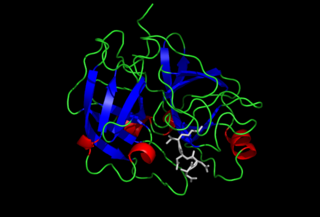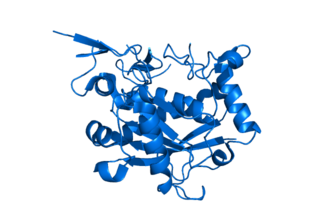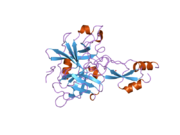
Enteropeptidase is an enzyme produced by cells of the duodenum and is involved in digestion in humans and other animals. Enteropeptidase converts trypsinogen into its active form trypsin, resulting in the subsequent activation of pancreatic digestive enzymes. Absence of enteropeptidase results in intestinal digestion impairment.

Activin receptor type-1B is a protein that in humans is encoded by the ACVR1B gene.

Maspin is a protein that in humans is encoded by the SERPINB5 gene. This protein belongs to the serpin superfamily. SERPINB5 was originally reported to function as a tumor suppressor gene in epithelial cells, suppressing the ability of cancer cells to invade and metastasize to other tissues. Furthermore, and consistent with an important biological function, Maspin knockout mice were reported to be non-viable, dying in early embryogenesis. However, a subsequent study using viral transduction as a method of gene transfer was not able to reproduce the original findings and found no role for maspin in tumour biology. Furthermore, the latter study demonstrated that maspin knockout mice are viable and display no obvious phenotype. These data are consistent with the observation that maspin is not expressed in early embryogenesis. The precise molecular function of maspin is thus currently unknown.

Fibroblast growth factor receptor 4 is a protein that in humans is encoded by the FGFR4 gene. FGFR4 has also been designated as CD334.

Caspase-10 is an enzyme that, in humans, is encoded by the CASP10 gene.

Cyclic AMP-dependent transcription factor ATF-1 is a protein that in humans is encoded by the ATF1 gene.

Kallikrein-2 is a protein that in humans is encoded by the KLK2 gene, and is particularly associated with prostatic tissue.

Activating transcription factor 6, also known as ATF6, is a protein that, in humans, is encoded by the ATF6 gene and is involved in the unfolded protein response.

Ribosomal protein S6 kinase alpha-5 is an enzyme that in humans is encoded by the RPS6KA5 gene. This kinase, together with RPS6KA4, are thought to mediate the phosphorylation of histone H3, linked to the expression of immediate early genes.

Suppressor of tumorigenicity 14 protein, also known as matriptase, is a protein that in humans is encoded by the ST14 gene. ST14 orthologs have been identified in most mammals for which complete genome data are available.

A disintegrin and metalloproteinase with thrombospondin motifs 1 is an enzyme that in humans is encoded by the ADAMTS1 gene.

Kunitz-type protease inhibitor 2 is an enzyme inhibitor that in humans is encoded by the SPINT2 gene. SPINT2 is a transmembrane protein with two extracellular Kunitz domains to inhibit serine proteases. This gene is a presumed tumor suppressor by inhibiting HGF activator which prevents the formation of active hepatocyte growth factor. Mutations in SPINT2 could result in congenital sodium diarrhea (CSD).

Glia-derived nexin is a protein that in humans is encoded by the SERPINE2 gene.

MAP kinase-interacting serine/threonine-protein kinase 1 is an enzyme that in humans is encoded by the MKNK1 gene.

Macrophage-stimulating protein (MSP), also known as hepatocyte growth factor-like protein, is a protein that in humans is encoded by the MST1 gene.

Neuroserpin is a protein that in humans is encoded by the SERPINI1 gene.

Hepatocyte growth factor activator is a protein that in humans is encoded by the HGFAC gene.

Serine protease hepsin is an enzyme that in humans is encoded by the HPN gene.

Granzyme M is a protein that in humans is encoded by the GZMM gene.
Angiogenesis is the process of forming new blood vessels from existing blood vessels, formed in vasculogenesis. It is a highly complex process involving extensive interplay between cells, soluble factors, and the extracellular matrix (ECM). Angiogenesis is critical during normal physiological development, but it also occurs in adults during inflammation, wound healing, ischemia, and in pathological conditions such as rheumatoid arthritis, hemangioma, and tumor growth. Proteolysis has been indicated as one of the first and most sustained activities involved in the formation of new blood vessels. Numerous proteases including matrix metalloproteinases (MMPs), a disintegrin and metalloproteinase domain (ADAM), a disintegrin and metalloproteinase domain with throbospondin motifs (ADAMTS), and cysteine and serine proteases are involved in angiogenesis. This article focuses on the important and diverse roles that these proteases play in the regulation of angiogenesis.























